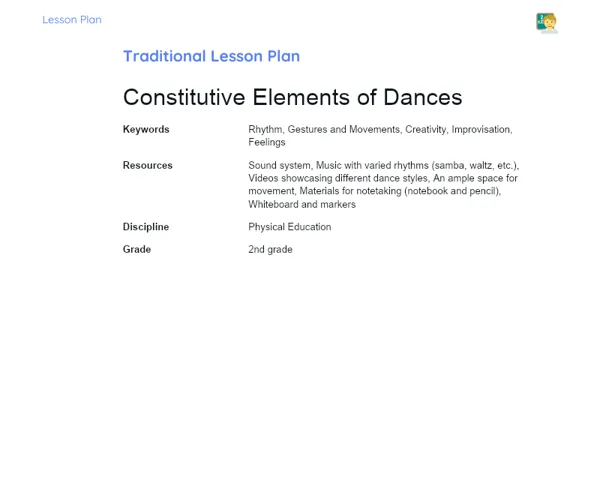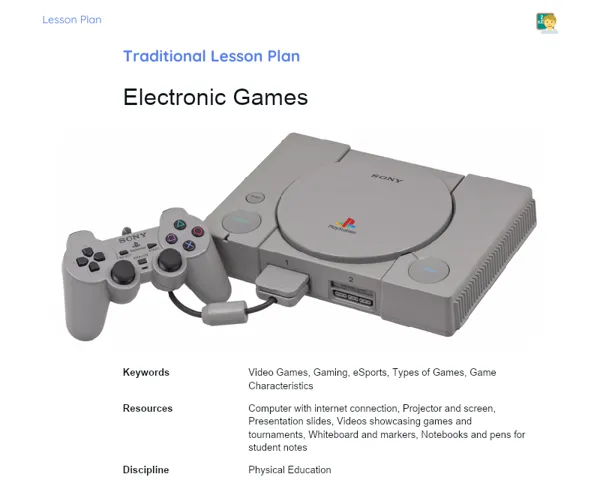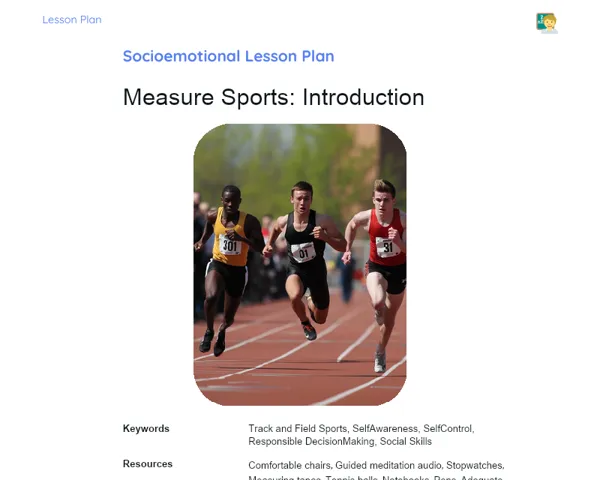Lesson Plan | Socioemotional Learning | Track and Field
| Keywords | Track and Field, Physical Education, Grade 11, Sprints, Race Walks, Throws, Jumps, Socio-emotional Skills, Self-awareness, Self-control, Responsible Decision Making, Social Skills, Social Awareness, RULER, Mindfulness, Emotional Regulation, Autonomy, Personal Goals |
| Resources | A spacious area for track and field activities, Cones for marking the different stations, Stopwatch, Throwing equipment (shot put, discus, javelin, hammer), Bar for high jump, Poles for pole vaulting, Notebooks for note-taking, Visual aids (posters, charts), Papers and pens for written reflections, Mats or cushions for mindfulness practice |
| Codes | - |
| Grade | 10th grade |
| Discipline | Physical Education |
Objective
Duration: 10 to 15 minutes
This phase of the Socio-emotional Lesson Plan aims to clearly communicate the specific objectives of the lesson to the students. By outlining what they are expected to learn and the skills required, students can better connect the lesson content to their own experiences and emotions. This facilitates the growth of socio-emotional skills like self-awareness and self-control, setting a motivating context for the lesson from the outset.
Objective Utama
1. Identify and describe the key events in track and field, including sprints, race walks, throws, and jumps.
2. Understand the basic rules and the effects of track and field activities on the human body, encouraging a reflection on the significance of sports for both physical and mental well-being.
3. Cultivate socio-emotional skills such as self-awareness and self-control through the practice and analysis of track and field events.
Introduction
Duration: 20 to 25 minutes
Emotional Warmup Activity
Mindfulness Moment
Mindfulness practice is an approach designed to help students stay present, thus improving their focus, attention, and concentration. In this session, students will be guided through several steps that encourage them to engage with their emotions and surroundings, promoting a calmer mindset as they enter the Physical Education class.
1. Request students to sit comfortably, with their backs straight and feet firmly on the ground.
2. Instruct them to close their eyes and place their hands on their knees, palms facing up.
3. Begin guiding them through deep breaths: inhale slowly through the nose, hold it for a few moments, then exhale gently through the mouth.
4. After a few breaths, encourage them to focus on the sensations of breathing and notice how the air flows in and out.
5. Motivate them to acknowledge any thoughts or feelings that arise without clinging to them, allowing them to drift away like clouds.
6. Lead them through a body scan, starting from their feet, noting any tension, and encouraging relaxation in those areas.
7. Wrap up this practice by asking students to slowly open their eyes and return their focus to the classroom, carrying with them a sense of calm and awareness.
Content Contextualization
Track and field, encompassing events such as sprints, race walks, throws, and jumps, demands not only physical skills but also emotional regulation. Consider an athlete on the verge of a 100-meter dash. The excitement, anticipation, and adrenaline are at an all-time high, yet they must sustain focus and control to excel. Today’s lesson will delve into both the techniques and the emotional aspects of track and field, examining how emotions impact performance and overall health. Mastering our emotions is critical for finding success and fulfillment in various activities, whether in sports or in life.
Development
Duration: 60 to 75 minutes
Theory Guide
Duration: 20 to 25 minutes
1. Sprints: Sprints are among the most exhilarating events in track and field, including distances like 100m, 200m, and 400m for short sprints, and 800m and above for longer races. A prime example is the 100m dash, showcasing explosive speed.
2. Race Walks: Race walking entails a distinctive technique where at least one foot must always be in contact with the ground. It’s important to clarify that mastering this technique is key to avoid disqualification.
3. Throws: This category includes shot put, discus, javelin, and hammer throw, each with unique techniques and rules. For instance, shot put requires a combination of strength and precise technique to launch the metal ball effectively.
4. Jumps: Events like high jump, pole vault, long jump, and triple jump fit here. In the high jump, athletes need to blend speed, jumping skills, and coordination to clear the bar without toppling it.
5. Rules and Body Impacts: Different events carry their own set of rules, which athletes must adhere to avoid penalties or disqualification. The physical toll on the body varies from event to event, necessitating distinct types of physical and mental preparation. For example, long-distance running primarily demands strong cardiovascular endurance, while throwing events rely heavily on muscular strength.
Activity with Socioemotional Feedback
Duration: 40 to 50 minutes
Track and Field Circuit with Socio-emotional Reflection
Students will engage in a series of activities arranged in a circuit that replicate various track and field events. Each station will represent a unique event, allowing students the chance to practice while reflecting on their emotions and performance.
1. Divide the class into smaller groups and assign them to various circuit stations (running, walking, throwing, and jumping).
2. Explain the essential rules and techniques for each event before they start practicing.
3. Each group will spend a designated amount of time (around 10 minutes per station) to practice.
4. During their practice, encourage students to be mindful of their own emotions and those of their classmates, paying attention to any feelings or reactions they observe.
5. After all stations, reconvene the students in a circle for a group discussion.
Discussion and Group Feedback
Following the practice, facilitate a group discussion using the RULER approach. Recognize the emotions observed during activities by prompting students to share their feelings at each station (e.g., anxiety, excitement, or frustration). Understand the reasons behind those emotions: inquire what triggered these feelings (challenges with technique, successful execution, or camaraderie with peers). Label the emotions correctly: assist students in properly identifying and naming their feelings. Express emotions appropriately: talk about how they expressed these feelings during the activities (positively or negatively). Regulate emotions effectively: propose strategies for managing emotions during sports, like deep breathing, concentrating on technique, and encouraging peer support. This reflection will aid students in understanding their emotional responses and enhancing their self-awareness and self-control.
Conclusion
Duration: 15 to 20 minutes
Reflection and Emotional Regulation
For the reflective and emotional regulation component, suggest a group discussion or a written exercise. Prompt students to compose one or two paragraphs discussing the challenges they faced during class and how they coped with their feelings. Encourage them to ponder questions like: What emotions did they experience during each event? How did those feelings impact their performance? What techniques did they employ to manage those emotions and maintain focus? In the discussion, motivate students to share their stories while listening to their classmates, fostering a supportive atmosphere.
Objective: The purpose of this activity is to promote self-reflection and emotional regulation. By examining the challenges encountered and the tactics used to cope with emotions, students can identify effective ways to manage difficult situations in the future, both in sports and other areas of their lives. This enhances self-awareness and self-control, crucial for socio-emotional growth.
Glimpse into the Future
At the end of the lesson, the teacher can guide students in setting personal and academic goals related to the day's activities. Ask them to identify specific targets they wish to accomplish regarding the track and field events practiced. They may jot down these objectives and share a few with the class if they like. Discuss the significance of establishing clear and achievable goals, and how this can facilitate their continual improvement in both physical and emotional skills.
Penetapan Objective:
1. Enhance technique in a particular track and field event.
2. Boost physical endurance for long-distance events.
3. Improve self-regulation in high-stress situations.
4. Foster teamwork and support skills among classmates.
5. Create a consistent practice routine outside of Physical Education classes. Objective: This section aims to cultivate students' independence and practical application of what they've learned. By setting personal and academic goals, students are encouraged to further develop their physical and emotional abilities, strengthening their sense of responsibility and commitment to personal growth. This also cultivates a forward-thinking perspective, where learning through Physical Education translates into lasting and meaningful improvements in their lives.



